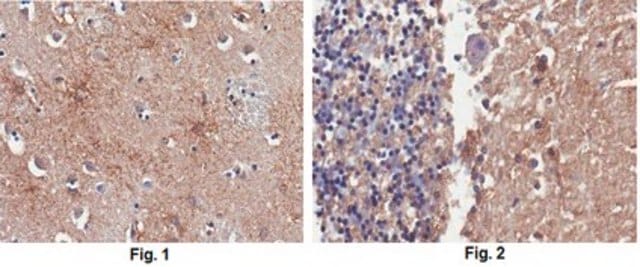MAB1596
Anti-Post Synaptic Density Protein 95 Antibody, clone 6G6-1C9
clone 6G6-1C9, Chemicon®, from mouse
Synonym(e):
PSD-95
About This Item
Empfohlene Produkte
Biologische Quelle
mouse
Qualitätsniveau
Antikörperform
purified immunoglobulin
Antikörper-Produkttyp
primary antibodies
Klon
6G6-1C9, monoclonal
Speziesreaktivität
mouse, rat, bovine
Hersteller/Markenname
Chemicon®
Methode(n)
immunocytochemistry: suitable
immunohistochemistry: suitable
western blot: suitable
Isotyp
IgG2a
NCBI-Hinterlegungsnummer
UniProt-Hinterlegungsnummer
Versandbedingung
dry ice
Posttranslationale Modifikation Target
unmodified
Angaben zum Gen
bovine ... Dlg4(100137840)
mouse ... Dlg4(13385)
rat ... Dlg4(29495)
Allgemeine Beschreibung
Spezifität
Immunogen
Anwendung
Neurowissenschaft
Synapsen & Synapsenbiologie
Representative image from a previous lot.
Confocal fluorescent analysis of PC12 using MAb1596 Mouse mAB (Red). Actin filaments have been labeled with Alexa Fluor 488 -Phalloidin (Green). Nuclear is stained with DAPI (Blue). Membrane staining positive.
Immunocytochemistry:
12.5 µg/mL
Western Blot:
1-5 μg/mL (ECL) on rat brain lysate (20 μg).
Optimal working dilutions must be determined by the end user.
Qualität
Zielbeschreibung
Verlinkung
Physikalische Form
Lagerung und Haltbarkeit
Handling Recommendations: Upon first thaw, and prior to removing the cap, centrifuge the vial and gently mix the solution. Aliquot into microcentrifuge tubes and store at -20°C. Avoid repeated freeze/thaw cycles, which may damage IgG and affect product performance. Note: Variabillity in freezer temperatures below -20°C may cause glycerol containing solutions to become frozen during storage.
Hinweis zur Analyse
Mouse brain, rat brain tissue.
Sonstige Hinweise
Rechtliche Hinweise
Haftungsausschluss
Not finding the right product?
Try our Produkt-Auswahlhilfe.
Empfehlung
Lagerklassenschlüssel
10 - Combustible liquids
WGK
WGK 2
Analysenzertifikate (COA)
Suchen Sie nach Analysenzertifikate (COA), indem Sie die Lot-/Chargennummer des Produkts eingeben. Lot- und Chargennummern sind auf dem Produktetikett hinter den Wörtern ‘Lot’ oder ‘Batch’ (Lot oder Charge) zu finden.
Besitzen Sie dieses Produkt bereits?
In der Dokumentenbibliothek finden Sie die Dokumentation zu den Produkten, die Sie kürzlich erworben haben.
Unser Team von Wissenschaftlern verfügt über Erfahrung in allen Forschungsbereichen einschließlich Life Science, Materialwissenschaften, chemischer Synthese, Chromatographie, Analytik und vielen mehr..
Setzen Sie sich mit dem technischen Dienst in Verbindung.








